
Alstroemeria, commonly called the Peruvian lily or lily of the Incas, is a genus of flowering plants in the family Alstroemeriaceae. They are all native to South America, although some have become naturalized in the United States, Mexico, Australia, New Zealand, Madeira and the Canary Islands. Almost all of the species are restricted to one of two distinct centers of diversity: one in central Chile and southern Argentina, the other in eastern Brazil. Species of Alstroemeria from Patagonia are winter-growing plants, while those of Brazil are summer growing. All are long-lived perennials except A. graminea, a diminutive annual from the Atacama Desert of Chile.

Lavandula angustifolia, formerly L. officinalis, is a flowering plant in the family Lamiaceae, native to the Mediterranean. Its common names include lavender, true lavender and English lavender ; also garden lavender, common lavender and narrow-leaved lavender.

Cobaea scandens, the cup-and-saucer vine, cathedral bells, Mexican ivy, or monastery bells, is a species of flowering plant in the phlox family Polemoniaceae. It is native to Mexico, with isolated sightings elsewhere in tropical central and South America.

Veronicastrum virginicum, or Culver's root, is a species of flowering plant in the plantain family, Plantaginaceae. It is native to the eastern United States and south-eastern Canada. Growing to 200 cm (79 in) tall by 45 cm (18 in) broad, it is an erect herbaceous perennial with slender racemes of white or occasionally pink or purple flowers in summer.

Impatiens repens, the Ceylon balsam, yellow impatiens, or creeping balsam, is a species of flowering plant in the family Balsaminaceae, from Sri Lanka. As the Latin name repens indicates, it is a low-growing plant with a creeping habit. This evergreen perennial can be found in wet-zone rain forests. Growing to 50 cm (20 in) tall and broad, it has small kidney-shaped leaves borne on red stems, and hooded yellow flowers in summer and autumn. It can be seen cultivated in gardens as an ornamental plant. In temperate zones it must be protected from temperatures below 10 °C (50 °F), so must be grown under glass during the winter months, It requires a sheltered position in partial shade.
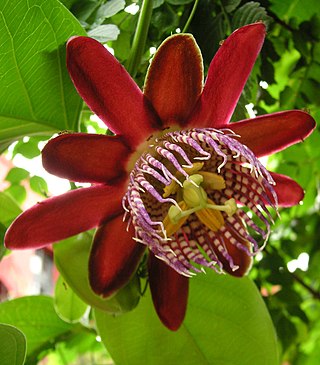
Passiflora alata, the winged-stem passion flower, is a species of flowering plant. It is an evergreen vine, growing to 6 m (20 ft) or more, which bears an edible type of passion fruit. It is native to the Amazon, from Peru to eastern Brazil.

Hibbertia scandens, sometimes known by the common names snake vine, climbing guinea flower and golden guinea vine, is a species of flowering plant in the family Dilleniaceae and is endemic to eastern Australia. It is climber or scrambler with lance-shaped or egg-shaped leaves with the narrower end towards the base, and yellow flowers with more than thirty stamens arranged around between three and seven glabrous carpels.

Viburnum plicatum is a species of flowering plant in the family Adoxaceae, native to mainland China, Korea, Japan, and Taiwan. The Latin specific epithet plicatum means "pleated", referring to the texture of the leaves.

Gypsophila repens, the alpine gypsophila or creeping baby's breath, is a species of flowering plant in the family Caryophyllaceae, native to the mountains of central and southern Europe, where it grows on dry, chalky slopes. The Latin name literally means "creeping chalk-lover". It is a prostrate, mat-forming herbaceous perennial, growing around 20 cm (8 in) tall by 30–50 cm (12–20 in) wide. For much of the summer it bears masses of star-shaped flowers which may be white, lilac or light purple, in loose panicles.
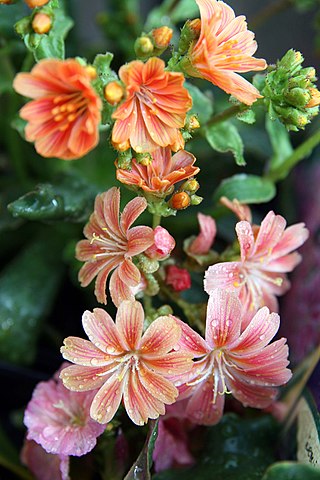
Lewisia cotyledon is a species of flowering plant in the family Montiaceae known by the common names Siskiyou lewisia and cliff maids. It is native to southern Oregon and northern California, where it grows in rocky subalpine mountain habitat.
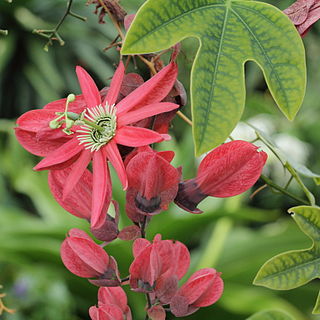
Passiflora racemosa, the red passion flower, is a species of flowering plant in the family Passifloraceae, native to Brazil. It is an evergreen climber growing to 5 m (16 ft), with simple or 3-lobed leaves to 10 cm (4 in) long, and vivid red flowers borne in summer. The flowers are 12 cm (5 in) in diameter, with purple and white coronas. They are followed by oblong green fruits.

Peperomia argyreia, the watermelon peperomia, is a species of flowering plant in the pepper family Piperaceae, native to northern South America, including Bolivia, Brazil, Ecuador, and Venezuela. The plant is not closely related to either watermelons or begonias. These terms relate to the shape, markings and texture of the leaves. Growing to 20 cm (7.9 in) tall and broad, it is an evergreen perennial with asymmetrical oval green leaves, slightly fleshy, strikingly marked with curved silver stripes, and red stems. Tiny green flower spikes appear in summer.

Iris lutescens, the Crimean iris, is a rhizomatous flowering plant in the genus Iris. It is native to North East Spain, Southern France and Italy. It is found on rocky or sandy hillsides or in woodlands.

Aeschynanthus pulcher, the lipstick plant or red bugle vine, is a species of evergreen perennial plant in the family Gesneriaceae, native to Indochina and western Malesia. An epiphytic climber, it produces clusters of red flowers from summer to winter. The common name "lipstick plant" refers to the bright red tubular flowers, about 6 cm long, that emerge from a maroon calyx, which resemble lipstick emerging from a tube. The plant may grow 60 cm to 2 meters tall, with an average spread of 50 cm. The leaves are elliptic and are arranged in pairs, with smooth edges.

Azara microphylla, the boxleaf azara, is a species of flowering plant in the willow family Salicaceae, native to Chile and Argentina. Growing to 10 metres (33 ft), it is a small, upright, evergreen tree or large shrub. It has small, shiny, very dark green leaves and tiny, vanilla-scented flowers in winter. It is the hardiest of the azaras, withstanding temperatures down to −15 °C (5 °F), but in cooler temperate regions requires some protection from cold winds. It also tolerates full shade.

Kalanchoe marmorata, the penwiper, is a species of flowering plant in the family Crassulaceae, native to Central and East Africa, from Zaire to Ethiopia, Sudan and Somalia. It is an erect or decumbent succulent perennial growing to 40 cm (16 in) tall and wide, with glaucous leaves spotted with purple, and starry white, four-petalled flowers, sometimes tinged with pink, in spring. As the minimum temperature for cultivation is 12 °C (54 °F), in temperate regions it is grown under glass as a houseplant.

Pleroma urvilleanum, synonym Tibouchina urvilleana, is a species of flowering plant in the family Melastomataceae, native to Brazil.
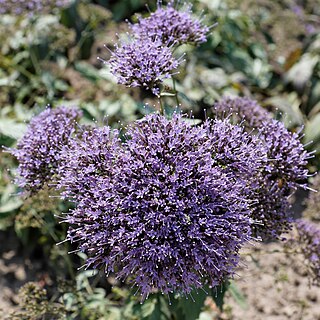
Trachelium caeruleum, common name blue throatwort, is a species of flowering plant in the family Campanulaceae native to the Mediterranean, where its native range includes Algeria, Morocco, Portugal, Spain, and Sicily. It has also become naturalized in a few areas, including New Zealand, the Azores, and parts of mainland Europe.

Jovellana is a genus of flowering plants in the family Calceolariaceae. It was formerly included in Scrophulariaceae, and is still listed by some authorities as belonging there. However, recent molecular research indicates that the family Scrophulariaceae was polyphyletic, meaning that it contained more than one lineage with different parents. So several of its genera - including Jovellana - have been split off and assigned to new or existing families.
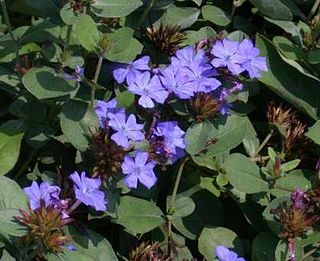
Ceratostigma plumbaginoides, the hardy blue-flowered leadwort, is a species of flowering plant in the plumbago family, native to China, where it is known as 蓝雪花.




















